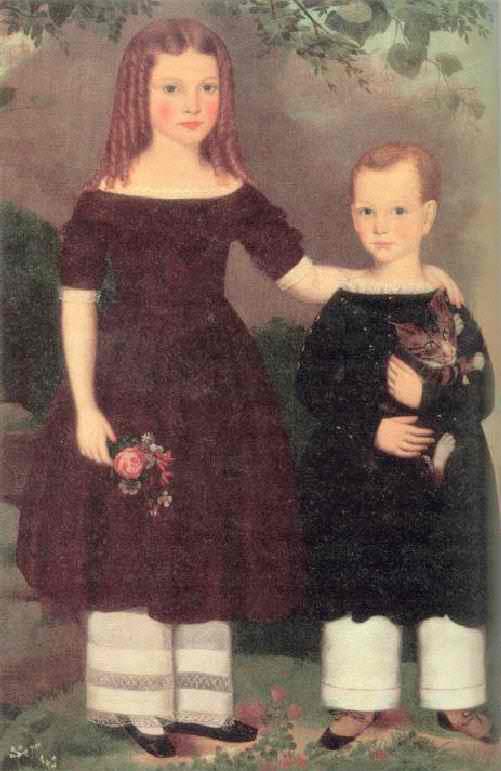
Pantalettes Styles

Figure 1.--This American brother and sister are dressed in similar, but not identical dresses and pantalettes. the painting is dated 1843, although we do not know the painter. Notice that while they are dressed similarly, they have very different hair syles. The girl has long ringlers, while her little brother has a short hair cut. Note the different styles of pantalettes that the two are wearing.
|
Pantalettes or pantalets/pantaloons are long drawers, some with fancy lace frills or other finish at the bottom of each leg. They were widely worn by women and children (boys and girls) during the first half of the 19th century. Pantalettes were worn virtually the entire 19th Century although they were much less commonly worn by the 1870s. Over this period of time there were many stylistic changes. The most obvious was the length of the pantalettes, but many stylistic features also changed as well.
Pantalette Length
Pantaletts have varied considerably, from above theknee to ankle length. The pantaletts when they first appeared at the turn of the 19th Century, extended below the hem of the dresses worn by boys and girls and the ankle and calf-length trousers worn by boys. In the early 19th century it was not considered proper for even small children to have bare legs. In fact the word leg was not used in polite company, rather the early victorians referred to limbs. As the 19th Century progressed and dresses became shorter, pantalettes some pantalettes also abecame shorter. Some long pantalettes were also worn with the shorter dresses, but this was more stylish for girls than for boys.
The length was primarily a reflection of changing fashion trends. I believe a child's pantalettes were all about the saame length. He may have had different styles for different occasions. I do not think that a child would have had different lengths of pantalettes to wear.
Style
Pantalette styles have also varied considerably. I believe they were mostly white, but there were both plain and fancy styles. The plain tyles were the most popular for boys, both this varied as to whether they were for everyday wear or for special occasions.
Some pantalettes were quite plain functional garments. These were often stright cut drawers almost entirely devoid of any fancy work or embelishment. The plainer styles was the most commonly worn by boys in the early 19th Century. But the boys who were still wearing pantalettes in the late 19th Century almost always wore them with lace or ruffled trim at the pantalette leg trim.
Fancy pantalettes, in sharp contrast, to the plain styled-pantalettes, were made in a myriad of different styles. Most pantalettes appear to have been white, but they varied widely in shape and adornment. Many were heavily festooned with lace and ruffled trim and often had elaborate tucks when the trim was not just at the pantalette leg bottom. Some pantalettes had extensive embroidery work. Pretilly trimmed pantalettes were a very important part of a girl's outfit and some mothers insisted on the same look for their sons. Intially the fancy lace and ruffle trim would cover than ankles, but eventually the length of the pantalettes rose and the trim was not used to cover the ankles but purely for ornamentation.
Gender Differences
HBC ha not noted significant gender differences concerning the length of the pantalettes worn by children. Rather the length was a featured that fluctuated chronologically as dress lenghths varied and popular concepts of propriety changed. The styling of te pantalettes did, however, vary according to gender. Boys tended to wear much plainer oantalettes than girls with fewer frills and lace trimming. There were probably fancy and everyday pantalettes for children. Presumably a child, however, would wear his or her fanciest pantalettes for a portrait. And even in these fornmal portraits boys commonly wear much paliner pamtalettes than their sisters.
Christopher Wagner

Navigate the Boys' Historical Clothing Web Site:
[Return to the Main Pantelettes page]
[Introduction]
[Activities]
[Chronology]
[Clothing styles]
[Biographies]
[Bibliographies]
[Contributions]
[Countries]
[FAQs]
[Boys' Clothing Home]
Created: January 23, 1999
Last updated: November 27, 2001



